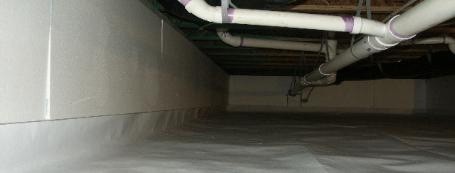
Did You Know?
According to ‘Crawlspace Science’ between 40 to 60 percent of the air we breathe in our home comes from the crawlspace. Air will enter the crawlspace through vents, or even small air gaps in the building. Once in the crawlspace air begins to warm up causing it to rise. The only place for the warm air to go is up through the house. This is called the stack effect.
The Problems:
Crawlspaces pose several challenges to home upkeep and maintaining healthy indoor environments.
- The stack effect described above results in crawlspace air and contaminates being drawn into a home’s living spaces.
- Summer months see warm air being drawn into cool crawlspaces. As the warm air cools moisture squeezed out of the air tends to collect on cool surfaces in the form of condensation. Once in the crawlspace moisture tends to remain trapped rather than exiting through vents as previously believed.
- During cold months crawlspace moisture tends to collect along cool rim joists (the exterior wood members of the floor structure) often trapping moisture against the wood structure in homes insulated to current building code.
- Bare or dirt crawlspaces allow moisture and gas seepage (such as Radon gases) from the ground to evaporate into crawlspace air.
- Building debris and organic materials such as cardboard boxes used for storage or ground covers often undergo decay due to prolonged exposure to moist ground.
- Moisture seepage from drainage and irrigation sources can feed crawlspace moisture.
- Crawlspace moisture settling on organic building structure can result in mold, fungi and decay, which in turn can release mold spore and mycotoxins.
- Dark largely undisturbed environments are attractive to insects and rodents, even more so when the environment is moist. Most insect species that are problematic to wood structures, (such as ants, termites, beetles, silverfish, etc.), are particularly drawn by dark moist areas.
Approaches to crawlspace remediation are dependent on environmental factors such as the presence of moisture, mold, insects, and by esoteric factors such as homeowner’s health, commitment to environmental health and capacity. Two common solutions are:
Solution 1: Basic cleanup
The basic minimum crawlspace cleanup should include removal of debris and all materials that are conducive to mold growth, especially if there is already mold or fungi on it. All crawlspaces should have a vapor barrier at the very least. Sealing all wood with an anti-microbial coating is optional except in cases of moderate to heavy mold growth.
Solution 2: Complete encapsulation
In addition to the basic cleanup, all wood materials can be sealed with an anti-microbial coating. The foundation vents are closed off. A heavy duty vapor barrier or liner is installed from the top of the concrete stem walls and over the entire ground surface with all the seams sealed. If radon gasses are your concern, special venting can be added to safely exhaust the gasses captured below the vapor barrier. If water is your concern, a sump pump can be installed to deal with groundwater and/or moisture problems. Complete encapsulation is an investment in the health of your family and the longevity of your home.

Would you eat lunch in YOUR crawlspace?
